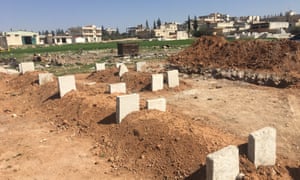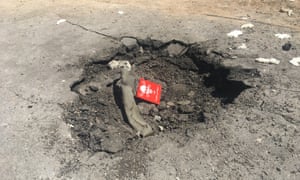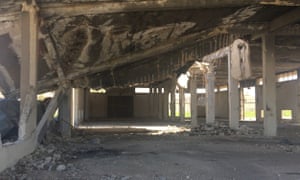Kareem Shaheen in Khan Sheikhun
The Guardian

Graves of the dead are still fresh from funerals the day before, the red soil still upturned. Photograph: Kareem Shaheen for the Guardian
Link
Khan Sheikhun is a ghost town, its streets deserted and silent as though mourning the victims of the atrocity that happened here two days earlier.
The only reminder of what happened is a small, blackened crater near the northern part of town, where a rocket laced with a nerve agent fell, killing more than 70 people in one of the worst mass casualty chemical attacks in the six-year war in Syria.
All that remains of the attack on the town in rebel-held Idlib province is a faint stench that tingles the nostrils and a small green fragment from the rocket. The houses nearby are emptied of the living.
The victims’ symptoms are consistent with sarin, the nerve agent that was dropped on an opposition-held area near Damascus in 2013, killing more than 1,000 people. After that attack the regime supposedly gave up its chemical weapons arsenal.
Moscow, Bashar al-Assad’s principal backer in the war, said the Syrian government had bombed a rebel-run toxic gas manufacturing plant in Khan Sheikhun, and that the gas subsequently leaked out.
The Guardian, the first western media organisation to visit the site of the attack, examined a warehouse and silos directly next to where the missile landed, and found nothing but an abandoned space covered in dust and half-destroyed silos reeking of leftover grain and animal manure.
Local residents said the silos had been damaged in air raids six months ago, and had stood unused since then.
“You can look at it; there’s nothing there except maybe some grain and animal dung, and there’s even a dead goat there that suffocated in the attack,” one local said. Residents responded in disbelief to the Russian allegation.
There was no evidence that any building had being hit in recent days or weeks near where so many people were killed and wounded by a nerve agent. The homes across the street appeared undamaged from the outside. There was no contamination zone near any building. Instead, the contamination area radiated from a hole in a road.
The Guardian interviewed witnesses, first responders, victims’ family members and the wounded in an effort to reconstruct the attack. They offered fresh details that shed new light on an incident that has prompted worldwide condemnation and refocused attention on the brutality of the Syrian war.
“It was like Judgment Day,” said Hamid Khutainy, a civil defence volunteer in Khan Sheikhoun.
Witnesses said the air raids began shortly after 6.30am on Tuesday, with four bombings around the town. Initially they thought it was just another airstrike, until the first responders who arrived at the scene began falling to the ground.
Khutainy said: “They told us, ‘HQ, we are losing control.’ We had no idea what they were trying to say. Then they said, ‘Come save us, we can no longer walk.’ So the second and third teams went with just face masks. We could smell it from 500 metres away.”
Local people and first responders described a scene of utter horror at the attack site. The wounded were shaking and convulsing on the ground, foaming at the mouth, their lips blue, passing in and out of consciousness.
“I found children lying on the ground, in their last breaths, their lips going blue,” said Abu al-Baraa, lives nearby and rushed to help when the full extent of what had happened dawned on him.
“We went into the houses and we found children dead in their beds, people who were trying to flee down the stairs who collapsed in their place,” he said, standing across the street from the crater left by the missile. “People on the rooftops and in the basements. People on the ground in the street. Wherever you looked there were dead human beings.”
The suffocating patients and the dead were taken to the nearby civil defence centre and the adjacent clinic, built into the side of a rocky mountainous outcrop to withstand potential airstrikes. The dead were laid in a nearby shed while emergency workers hosed down the injured with water and administered atropine, a nerve agent antidote.
But while medical workers were trying to come to grips with the crisis, between eight and 10 airstrikes targeted the medical facility and civil defence centre. The shed collapsed on the dead, and the site was put out of service.
“Maybe the pilots heard the myth that you could come back to life 48 hours after dying from sarin, so they decided to bomb them again just in case,” said an official from the Ahrar al-Sham rebel group who was on the scene. “Thank God there is a Day of Judgment in the afterlife.”
The Guardian visited the destroyed medical facility and civil defence centre briefly. Local people said reconnaissance planes had been spotted in the sky earlier and believed the area might be targeted again later in the day.
The site was filled with rubble. Inside, hospital equipment, beds, surgical instruments and small boxes of medicine lay covered in dust or broken on the ground. There were no weapons in sight, and the rooms inside the cave were darkened with the electricity knocked out.
In a nearby cemetery, the graves of the dead are still fresh from the funerals the day before, the red soil still upturned. In one corner 18 new graves were set up, the names barely etched with a rough chisel on the tombstones. They contained the bodies of 20 people, including two children who were buried with their mother. They were all from the same family.
Abdulhamid al-Yousef, one of the few survivors in the family, was receiving condolences at his home in Khan Sheikhoun, a day after burying his wife and nine-month-old twins, Ahmed and Aya, fighting back tears.
Yousef had rushed to help the other victims of the attack. He came back instead to find that much of his family had perished, including siblings, nephews and nieces. His wife and children had rushed down to the bomb shelter in their basement, only for the toxic gas to seep into it, killing them all.
That evening at the cemetery, he insisted on carrying his two infants in his arms to bury them himself.
Abdulhamid, almost in a trance, repeated the children’s names, choking as he did so.
“Aya, and Ahmed, my souls. Yasser and Ahmed, my brothers who had my back. Ammoura and Hammoudi, Shaimaa, so many others,” he said.



No comments:
Post a Comment